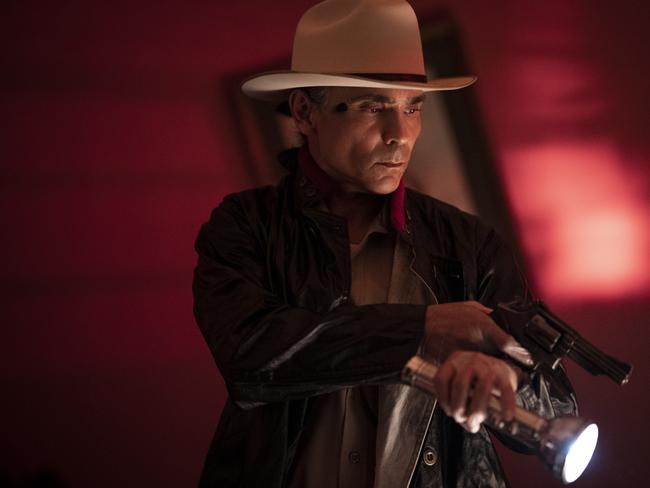Crime drama Dark Winds taps the spell of the Navajo desert
This beguiling Western thriller told from the perspective of Indigenous people is based on Tony Hillerman’s mystery series about two Navajo cops.

I’ve just caught up with the brilliant new crime drama Dark Winds, following the investigations of a couple of Navajo tribal detectives which, like so many new series these days, arrived with little fanfare, promotion or even advance warning.
There is an assumption in this streaming age that overwhelmingly TV content is regarded as self-explanatory and sometimes it’s easy to miss the new. Watching TV is work in this new era of convergence between different technologies and cultural forms. Keeping up, even for critics, is difficult.
Certainly, Dark Winds, created by Graham Roland, rewards the effort. It’s a beguiling Western thriller, set in the early 1970s, produced from the perspective of Indigenous people. Roland is an expert at mysteries and is a writer on shows such as Prison Break, Lost and Fringe. He also co-created the Tom Clancy series Jack Ryan, and is of Native American heritage, a Chickasaw Nation citizen.
The show’s director, Chris Eyre, is of Cheyenne and Arapaho descent, and worked on shows such as Skins, shot entirely on the Pine Ridge Reservation in South Dakota, and The legend of Jedediah Smith, as well as episodes of Law and Order and Friday Night Lights.
And to ensure authenticity, most of the actors and crew are Native American and much of the production was shot with special permission on tribal lands at Tesuque Pueblo in New Mexico, using their facility, Camel Rock Studios. The rest was filmed on tribal lands at Cochiti Pueblo, also in New Mexico.
Executive producers are George R.R. Martin, the creator of Game of Thrones, Robert Redford, and Zahn McClarnon – who also plays the lead role of Joe Leaphorn, a tribal investigator and Vietnam veteran with a degree in anthropology. He’s an actor of Hunkpapa and Sihasapa Lakota Native American descent.
It’s all based on the novels of Tony Hillerman, who died in 2008, known for his 18 novels in the Navajo Tribal Police mystery series. They’re set in the Four Corners region of the Southwest United States, and feature two Navajo cops, war veteran Joe Leaphorn and, a little later, the younger Jim Chee. He’s a staunch believer in traditional Navajo culture, studying to be a traditional healer while he’s a police officer. His Navajo name, given to him by his maternal uncle, is Long Thinker.
Other crime writers, such as William Kent Krueger, author of the acclaimed Cork O’Connor mystery series centred on the Ojibwe tribes around the Great Lakes, say it was Hillerman who opened a gate though which they passed, like the million others who read his books, to a world about which they knew almost nothing. While his characters were memorable, his sense of place profound, it was the way he so deliciously took his readers into a culture that was not only exotic but oddly familiar, cleverly melding Navajo traditions with the modern world.
All of it – the murders, kidnappings, missing persons, assaults, bank heists, and the mysterious, exotic encounters with ghosts and Skinwalkers – took place in the canyons and mesa and the blinding blue sky of Arizona, New Mexico and Utah.
Notably, when Hillerman first submitted his debut novel, The Blessing Way to an agent, she told him it wasn’t too good and famously advised him to get rid of the Indian stuff. He went on to win the Edgar, Anthony, Nero, Agatha, Macavity, and Spur awards for best crime novel, as well as France’s Grand Prix de Litterature Policier.
“His stories, while steeped in contemporary crime, often describe people struggling to maintain ancient traditions in the modern world,” the New York Times said in its obituary.
“The books are instructive about ancient tribal beliefs and customs, from purification rituals to incest taboos.”
Martin calls the Navajo Nation “the Land of Enchantment” and has been involved in the project for some years.
“Tony Hillerman was one of the greats, as every devoted reader knows. Down here in the Southwest, Joe Leaphorn and Jim Chee are as iconic as Sherlock Holmes, Hercule Poirot, Philip Marlowe, and Travis McGee,” he says.

Redford optioned the books for a TV adaptation more than 30 years ago, and Martin said in announcing the series’ commission, his dream was “to adapt as many of them as we can”.
It’s easy to understand his enthusiasm. In the early 70s, already familiar with Holmes, Poirot and Marlow I discovered McGee and for most of my waking hours, Fawcett paperback in hand, I saw myself as the “selvage consultant”, of the deepwater tan, scarred knuckles and untender mercies, a boat-bum private eye busting cold-hearted scammers and deranged developers determined to destroy the everglades of South Florida. But then came Hillerman’s Leaphorn and Chee, and I was transported to the mystery of the Navajos and the emergence of a couple of astute detectives of colour in a crime fiction world largely dominated by white male detectives and a spattering of female private eyes.
“Tony’s writing was so immersive when it came to place, time, the community, and you could just tell – he wasn’t Navajo – but he had spent a lot of time there in that community,” Roland says.
“The opportunity to bring this to a television audience, a world like this which has never been seen before, was the first thing that really grabbed me.”
The second thing that really gripped him was the fact that it wasn’t a story where a white character took the audience into a Native community. “This was told from a Native American protagonist’s point of view and you’re experiencing the world as he lived it.”
The first season is based on Hillerman’s novel The Whispering Woman, the first episode, “Monster Slayer”, starting in 1971, with a superbly staged armoured van robbery. Out of a cloudless sky a helicopter descends on the main street of Gallup, New Mexico just as two uniformed guards emerge from Gallup Savings & Loans.
They load the van with padlocked bags of cash but as they drive off the helicopter blocks the road. A bomb destroys the van, a gunfight follows, and masked bandits escape into the skies with the money. An aerial shot follows the bandits as the cityscape quickly transforms into the majestic buttes and spires of Monument Valley towards the Navajo reservation.
Three weeks later, deep in Navajo Nation, we are with Joe Leaphorn at the Big Rock Motel as he begins the investigation into the murders of an elderly man called Hosteen Tso (Harrison Lowe) and a young woman, Anna Atcitta (Shawnee Pourier), found dead in the bathtub. The killer took Tso’s liver and eyes, but Anna appears untouched.
To Leaphorn’s eye there is something oddly angelic about her death. The only witness is the woman’s grandmother, Margaret Cigaret (Betty Ann Tsosie), a blind healer who is so traumatised by the incident that she can’t even answer questions about it. She is known as the Listening Woman or Blind Eyes. Tso had visited Cigaret after being ill, his sickness beginning after he saw a mechanical bird with no wings or beauty. Already story threads start to entwine.
MORE TELEVISION: New Aussie series is Ozark meets Fargo and Schitt’s Creek | Inside a secret Israeli military force: Fauda a must-see | Policing in Belfast: Leave the name badge at home
Leaphorn and his loyal and dedicated “Number Two”, Sergeant Bernadette Manuelito (Jessica Matten), a full-blooded Navajo, are joined by Jim Chee, arriving at the Tribal cops’ rather worn headquarters in a flash car. Chee is a handsome young dude who, according to Manuelito uncannily resembles singer Pat Boone.
The FBI are soon involved, too, in the form of Leyland Stringer (Noah Emmerich), a jaded agent whose career is withering in the Navajo desert, known to Leaphorn as “High Pockets” for reasons yet unexplained.
He has little interest in the deaths and is only concerned with the possible involvement of radical Navajos in the bank heist.
“Bad Indians doing bad shit,” he tells Leaphorn. Complicating matters for Leaphorn is the simmering distrust of the tribal authorities by the local Navajo community.
The other main plotting arc involves Leaphorn’s wife Emma (Deanna Allison), a midwife at the local hospital who finds herself involved with a pregnant young woman possibly the victim of domestic violence and a doctor amiably threatening to sterilise her.
This was a common practice at the time, one of the many interwoven injustices endured by Native Americans, along with the horrors of the assimilationist Catholic Indian boarding schools of the era, an enduring memory for Joe Leaphorn.
It’s engrossing and directed with unassuming style by Eyre, who knows his way around the clashing of cultures. And he subtly explores the intricacies of Navajo life and the beguiling geography that sustains it. He’s not above a little humour either. As the helicopter zooms into the sky after the robbery, the camera catches sight of the town’s cinema, a billboard advertising Arthur Penn’s 1970 Little Big Man, celebrating Native Americans positively despite their usual portrayal as perpetrators of violence.
The acting is compelling, especially Zahn McClarnon’s Leaphorn. Short, gaunt and sceptical, he’s an actor of awkward grace patiently withheld emotionally, and as the Tribal cop able to present a sense of honesty and moral integrity, and an incorruptible strength of will. He’s wonderfully believable in this series, heartbreaking at times in the face of his outrage and helplessness in the face of class inequities and social injustices.
Dark Winds, streaming on Prime Video.


To join the conversation, please log in. Don't have an account? Register
Join the conversation, you are commenting as Logout